Nitrogen Isotope Fractionation during Composting of Sewage and Agri-Food Sludge with Pruning Waste
Abstract
1. Introduction
2. Materials and Methods
2.1. Composting Procedure
2.2. Chemical Determinations
2.3. Determination of δ15N Signature in the Initial and Composting Materials
2.4. Statistical Analyses
3. Results and Discussion
3.1. Chemical Characteristics and Isotopic Composition (δ15N) of the Initial Materials
3.2. Thermal Development of the Composting Mixtures
3.3. Composting Process: Effect on 15N Natural Abundance
3.4. Composting Process: Characteristics of the Composts
4. Conclusions
Author Contributions
Funding
Conflicts of Interest
References
- Santos, A.; Bustamante, M.A.; Tortosa, G.; Moral, R.; Bernal, M.P. Gaseous emissions and process development during composting of pig slurry: The influence of the proportion of cotton gin waste. J. Clean. Prod. 2016, 112, 81–90. [Google Scholar] [CrossRef]
- Kim, Y.J.; Choi, W.J.; Lim, S.S. Changes in nitrogen isotopic compositions during composting of cattle feedlot manure: Effects of bedding material type. Bioresour. Technol. 2008, 99, 5452–5458. [Google Scholar] [CrossRef] [PubMed]
- Barbanti, L.; Grigatti, M.; Ciavatta, C. Nitrogen release from a N15-labeled compost in a sorghum growth experiment. J. Plant Nutr. Soil Sci. 2011, 174, 240–248. [Google Scholar] [CrossRef]
- Bustamante, M.A.; Suárez-Estrella, F.; Torrecillas, C.; Paredes, C.; Moral, R.; Moreno, J. Use of chemometrics in the chemical and microbiological characterization of composts from agroindustrial wastes. Bioresour. Technol. 2010, 101, 4068–4074. [Google Scholar] [CrossRef]
- Gutiérrez, M.C.; Serrano, A.; Siles, J.A.; Chica, A.F.; Martín, M.A. Centralized management of sewage sludge and agro-industrial waste through co-composting. J. Environ. Manag. 2017, 196, 387–393. [Google Scholar] [CrossRef]
- Awasthi, M.K.; Pandey, A.K.; Bundela, P.S.; Khan, J. Co-composting of organic fraction of municipal solid waste mixed with different bulking waste: Characterization of physicochemical parameters and microbial enzymatic dynamic. Bioresour. Technol. 2015, 182, 200–207. [Google Scholar] [CrossRef]
- Hargreaves, J.C.; Adl, M.S.; Warman, P.R. A review of the use of composted municipal solid waste in agriculture. Agric. Ecosys. Environ. 2008, 123, 1–14. [Google Scholar] [CrossRef]
- Moretti, S.M.L.; Bertoncini, E.I.; Abreu-Junior, C.H. Composting sewage sludge with green waste from tree pruning. Sci. Agric. 2015, 72, 432–439. [Google Scholar] [CrossRef]
- Vico, A.; Pérez-Murcia, M.D.; Bustamante, M.A.; Agulló, E.; Marhuenda-Egea, F.C.; Sáez, J.A.; Paredes, C.; Pérez-Espinosa, A.; Moral, R. Valorization of date palm (Phoenix dactylifera L.) pruning biomass by co-composting with urban and agri-food sludge. J. Environ. Manag. 2018, 226, 408–415. [Google Scholar] [CrossRef]
- Pelegrín, M.; Sáez, J.A.; Andreu-Rodríguez, J.; Pérez-Murcia, M.D.; Martínez-Sabater, E.; Marhuenda-Egea, F.C.; Pérez-Espinosa, A.; Bustamante, M.A.; Agulló, E.; Vico, A.; et al. composting of invasive species Arundo donax with sewage and agri-food sludge: Agronomic, economic and environmental aspects. Waste Manag. 2018, 78, 730–740. [Google Scholar] [CrossRef]
- Morales, A.B.; Bustamante, M.A.; Marhuenda-Egea, F.C.; Moral, R.; Ros, M.; Pascual, J.A. Agri-food sludge management using different co-composting strategies: Study of the added value of the composts obtained. J. Clean. Prod. 2016, 121, 186–197. [Google Scholar] [CrossRef]
- Tejada, M.; Hernandez, M.T.; Garcia, C. Soil restoration using composted plant residues: Effects on soil properties. Soil Till. Res. 2009, 102, 109–117. [Google Scholar] [CrossRef]
- Masunga, R.H.; Uzokwe, V.N.; Mlay, P.D.; Odeh, I.; Singh, A.; Buchan, D.; De Neve, S. Nitrogen mineralization dynamics of different valuable organic amendments commonly used in agriculture. Appl. Soil Ecol. 2016, 101, 185–193. [Google Scholar] [CrossRef]
- Flores, P.; Fenoll, J.; Hellín, P. The feasibility of using δ15N and δ13C values for discriminating between conventionally and organically fertilized pepper (Capsicum annuum L.). J. Agric. Food Chem. 2007, 55, 5740–5745. [Google Scholar] [CrossRef]
- Chalk, P.M.; Inácio, C.T.; Magalhães, A.M.T. From fertilizer to food: Tracing nitrogen dynamics in conventional and organic farming systems using 15N natural abundance. In Proceedings of the International Symposium on Managing Soils for Food Security and Climate Change Adaptation and Mitigation, Vienna, Austria, 23–27 July 2012; Heng, L.K., Sakadevan, K., Dercon, G., Nguyen, M.L., Eds.; Food and Agriculture Organization of the United Nations: Rome, Italy, 2014. [Google Scholar]
- Bateman, A.S.; Kelly, S.D.; Woolfe, M. Nitrogen isotope composition of organically and conventionally grown crops. J. Agric. Food Chem. 2007, 55, 2664–2670. [Google Scholar] [CrossRef]
- Choi, W.J.; Ro, H.M.; Hobbie, E.A. Patterns of natural 15N in soils and plants from chemically and organically fertilized uplands. Soil Biol. Biochem. 2003, 35, 1493–1500. [Google Scholar] [CrossRef]
- Yun, S.I.; Ro, H.M. Natural 15N abundance of plant and soil inorganic-N as evidence for over-fertilization with compost. Soil Biol. Biochem. 2009, 41, 1541–1547. [Google Scholar] [CrossRef]
- Lynch, D.H.; Voroney, R.P.; Warman, P.R. Use of 13C and 15N natural abundance techniques to charavterize carbon and nitrogen dynamics in composting and in compost-amended soils. Soil Biol. Biochem. 2006, 38, 103–114. [Google Scholar] [CrossRef]
- Bustamante, M.A.; Alburquerque, J.A.; Restrepo, A.P.; de la Fuente, C.; Paredes, C.; Moral, R.; Bernal, M.P. Co-composting of the solid fraction of anaerobic digestates, to obtain added-value materials for use in agriculture. Biomass Bioenergy 2012, 43, 26–35. [Google Scholar] [CrossRef]
- Zucconi, F.; Pera, A.; Forte, M.; de Bertoldi, M. Evaluating toxicity of immature compost. Biocycle 1981, 22, 54–57. [Google Scholar]
- Paredes, C.; Roig, A.; Bernal, M.P.; Sánchez-Monedero, M.A.; Cegarra, J. Evolution of organic matter and nitrogen during co-composting of olive mill wastewater with solid organic wastes. Biol. Fertil. Soils 2000, 32, 222e. [Google Scholar] [CrossRef]
- Rigby, H.; Clarke, B.O.; Pritchard, D.L.; Meehan, B.; Beshah, F.; Smith, S.R.; Porter, N.A. A critical review of nitrogen mineralization in biosolids-amended soil, the associated fertilizer value for crop production and potential for emissions to the environment. Sci. Total Environ. 2016, 541, 1310–1335. [Google Scholar] [CrossRef] [PubMed]
- Evans, R.D. Physiological mechanisms influencing plant nitrogen composition. Trends Plant Sci. 2001, 6, 121–126. [Google Scholar] [CrossRef]
- Wankel, S.D.; Kendall, C.; Paytan, A. Using nitrate dual isotopic composition (δ15N and δ18O) as a tool for exploring sources and cycling of nitrate in an estuarine system: Elkhorn Slough, California. J. Geophys. Res. 2009, 114, G01011. [Google Scholar] [CrossRef]
- Lim, S.S.; Lee, S.M.; Lee, S.H. Nitrogen isotope compositions of synthetic fertilizer, raw livestock manure slurry and composted livestock manure. Korean J. Soil Sci. Fertil. 2010, 43, 453–457. [Google Scholar]
- Choi, W.J.; Arshad, M.A.; Chang, S.X.; Kim, T.H. Grain 15N of crops applied with organic and chemical fertilizers in a four-year rotation. Plant Soil 2006, 284, 165–174. [Google Scholar] [CrossRef]
- Santiago, L.S.; Silvera, K.; Andrade, S.L.; Dawson, T.E. Functional strategies of tropical dry forest plants in relation to growth form and isotopic composition. Environ. Res. Lett. 2017, 12, 115006. [Google Scholar] [CrossRef]
- Santiago, L.S.; Kitajima, K.; Wright, S.J.; Mulkey, S.S. Coordinated changes in photosynthesis, water relations and leaf nutritional traits of canopy trees along a precipitation gradient in lowland tropical forest. Oecologia 2004, 139, 495–502. [Google Scholar] [CrossRef]
- Chiarelotto, M.; Damaceno, F.M.; Lorin, H.E.F.; Tonial, L.M.S.; de Mendonça Costa, L.A.; Bustamante, M.A.; Moral, R.; Marhuenda-Egea, F.C.; Costa, M.S.S.M. Reducing the composting time of broiler agro-industrial wastes: The effect of process monitoring parameters and agronomic quality. Waste Manag. 2019, 96, 25–35. [Google Scholar] [CrossRef]
- Kramer, M.G.; Sollins, P.; Sletten, R.S.; Swart, P.K. N isotope fractionation and measures of organic matter alteration during decomposition. Ecology 2003, 84, 2021–2025. [Google Scholar] [CrossRef]
- Guo, R.; Li, G.; Jing, T.; Schuchardt, F.; Chen, T.; Zhao, Y.; Shen, Y. Effect of aeration rate, C/N ratio and moisture content on the stability and maturity of compost. Bioresour. Technol. 2012, 112, 171–178. [Google Scholar] [CrossRef] [PubMed]
- Sáez, J.A.; Clemente, R.; Bustamante, M.A.; Yañez, D.; Bernal, M.P. Evaluation of the slurry management strategy and the integration of the composting technology in a pig farm—Agronomical and environmental implications. J. Environ. Manag. 2017, 192, 57–67. [Google Scholar] [CrossRef] [PubMed]
- Inácio, C.T.; Urquiaga, S.; Chalk, P.M.; Mata, M.G.F.; Souza, P.O. Identifying N fertilizer regime and vegetable production system in tropical Brazil using 15N natural abundance. J. Sci. Food Agric. 2015, 95, 3025–3032. [Google Scholar] [CrossRef] [PubMed]
- Bustamante, M.A.; Paredes, C.; Moral, R.; Agullo, E.; Perez-Murcia, M.D.; Abad, M. Composts from distillery wastes as peat substitutes for transplant production. Resour. Conserv. Recycl. 2008, 52, 792–799. [Google Scholar] [CrossRef]
- Komilis, D.P. Compost quality: Is research still needed to assess it or do we have enough knowledge? Waste Manag. 2015, 38, 1–2. [Google Scholar] [CrossRef] [PubMed]
- Young, B.J.; Rizzo, P.F.; Riera, N.I.; Torre, V.D.; López, V.A.; Molina, C.D.; Fernández, F.E.; Crespo, D.C.; Barrena, R.; Komilis, D.; et al. Development of phytotoxicity indexes and their correlation with ecotoxicological, stability and physicochemical parameters during passive composting of poultry manure. Waste Manag. 2016, 54, 101–109. [Google Scholar] [CrossRef]
- Bernal, M.P.; Alburquerque, J.A.; Moral, R. Composting of animal manures and chemical criteria for compost maturity assessment. A review. Bioresour. Technol. 2009, 100, 5444–5453. [Google Scholar] [CrossRef]
- Rékasi, M.; Mazsu, N.; Drakovist, E.; Bernhardet, B.; Szabó, A.; Rivier, P.; Farkas, C.; Borsányi, B.; Pirkó, B.; Molnár, S.; et al. Comparing the agrochemical properties of compost and vermicompost produced from municipal sewage sludge digestate. Bioresour. Technol. 2019, 291, 121861. [Google Scholar] [CrossRef]
- Doublet, J.; Francou, C.; Poitrenaud, M.; Houot, S. Influence of bulking agents on organic matter evolution during sewage sludge composting; consequences on compost organic matter stability and N availability. Bioresour. Technol. 2011, 102, 1298–1307. [Google Scholar] [CrossRef]
- Awasthi, M.K.; Li, J.; Kumar, S.; Awasthi, S.K.; Wang, Q.; Chen, H.; Wang, M.; Ren, X.; Zhang, Z. Effects of biochar amendment on bacterial and fungal diversity for co-composting of gelatin industry sludge mixed with organic fraction of municipal solid waste. Bioresour. Technol. 2017, 246, 214–223. [Google Scholar] [CrossRef]
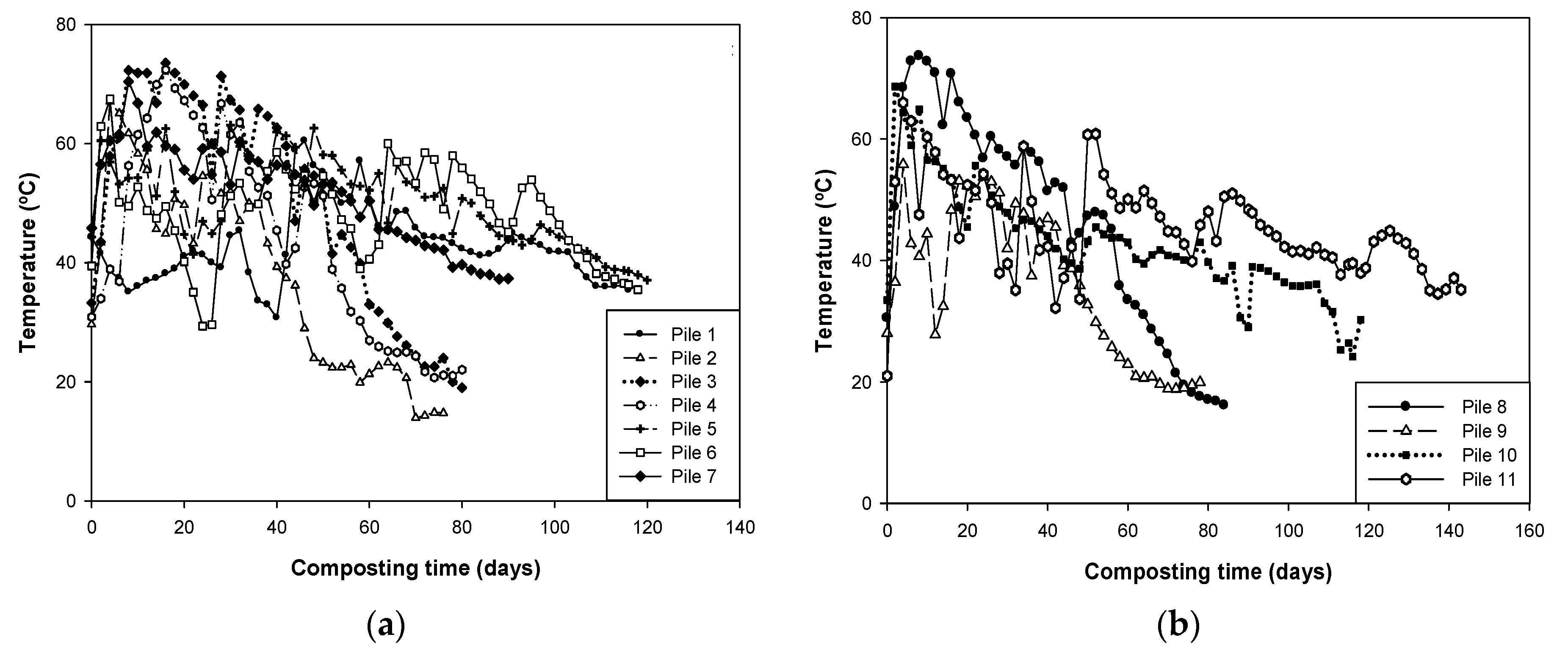
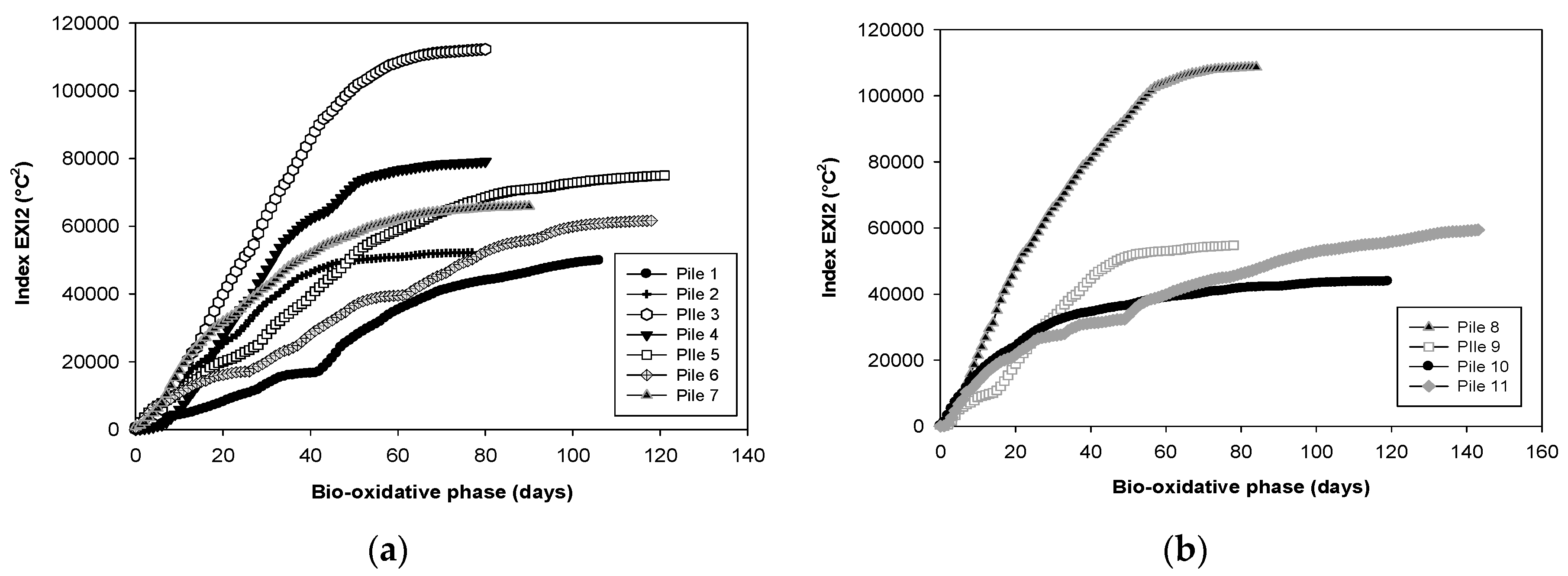
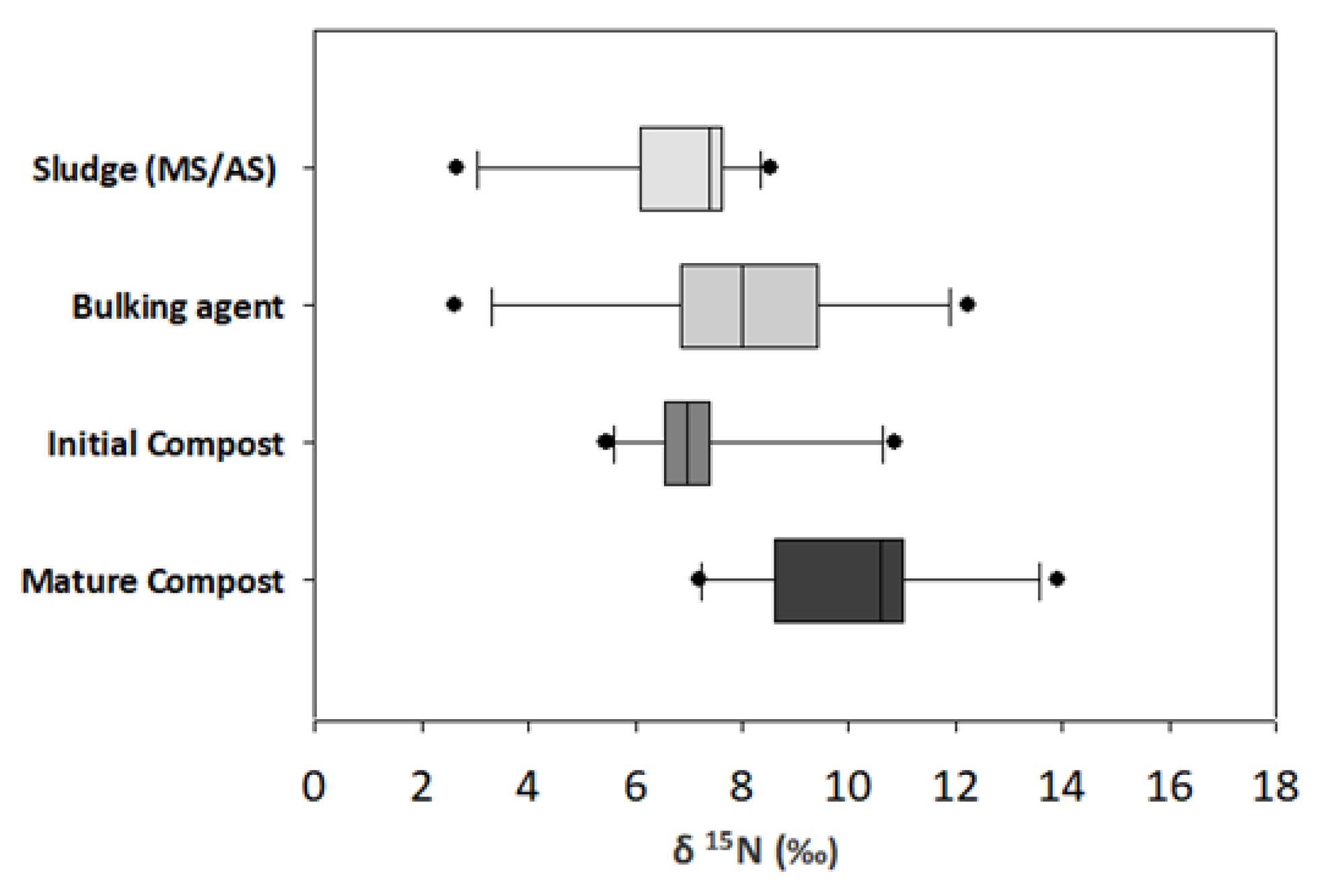
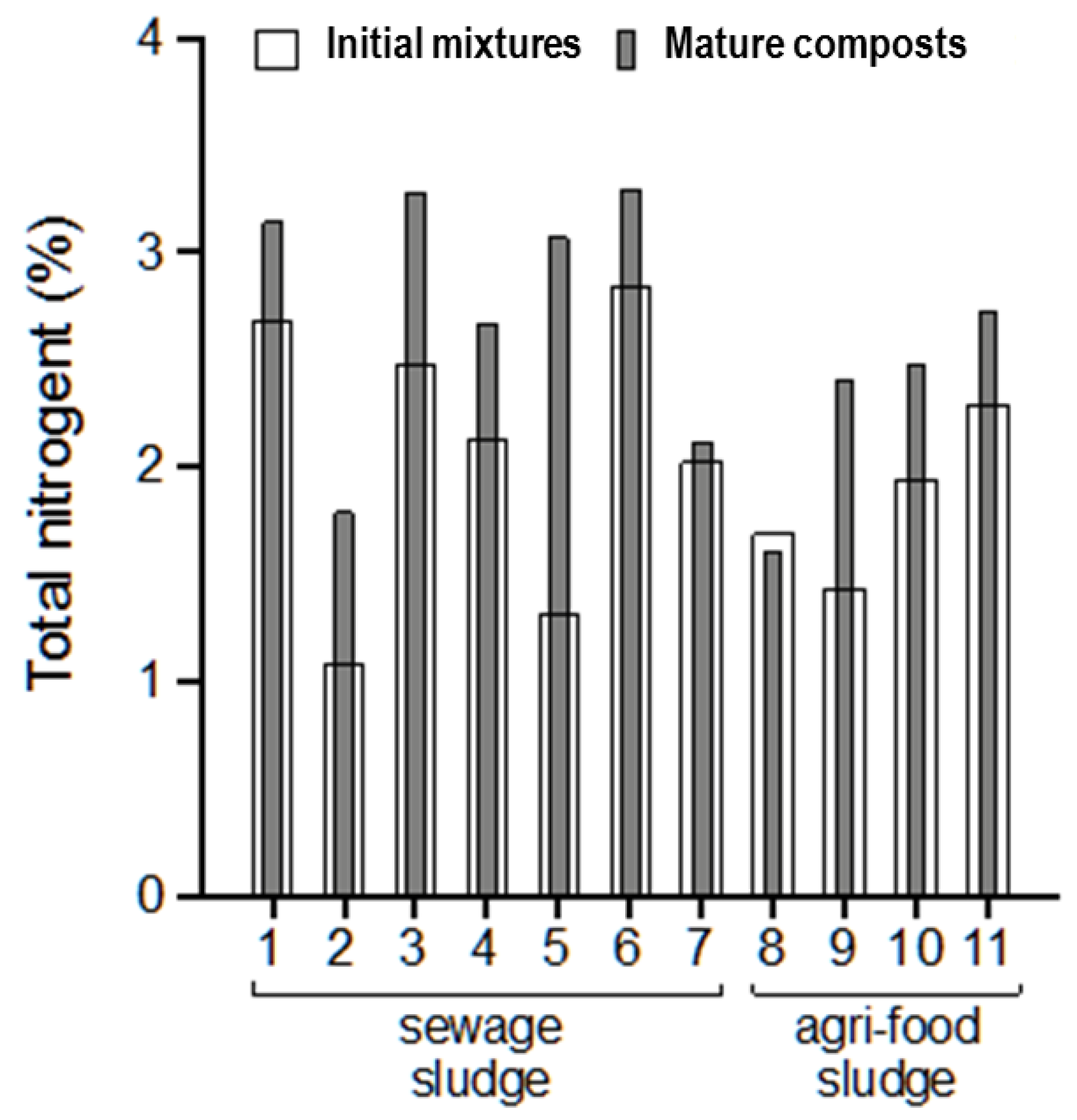
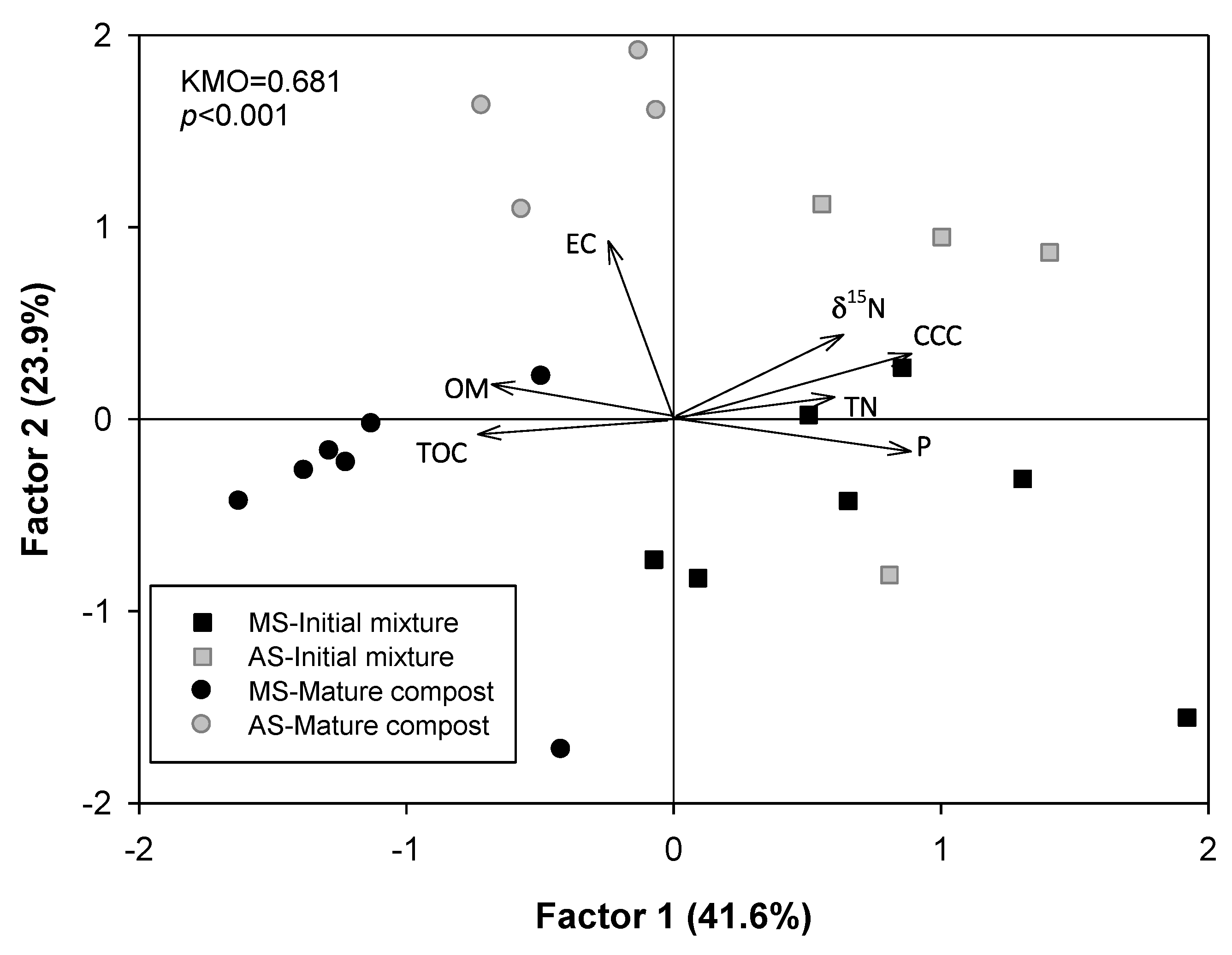
| Composting Pile | Raw Material | Bulking Agent | Ratio (Dry Weight) |
|---|---|---|---|
| 1 | 68% (MS2) | 32% (LP) | 36:64 |
| 2 | 60% (MS2) | 40% (AD) | 30:70 |
| 3 | 70% (MS2) | 30% (CG) | 38:62 |
| 4 | 75% (MS2) | 25% (GP) | 54:46 |
| 5 | 75% (MS3) | 25% (TW) | 41:59 |
| 6 | 85% (MS3) | 15% (MA) | 55:45 |
| 7 | 68% (MS4) | 32% (TP1) | 30:70 |
| 8 | 66% (AS1) | 34% (TP2) | 28:72 |
| 9 | 68% (AS2) | 32% (TP3) | 24:76 |
| 10 | 75% (AS3) | 25% (TP4) | 35:65 |
| 11 | 75% (AS4) | 25% (TP4) | 34:66 |
| Raw Material | pH | EC (dS/m) | OM (%) | TOC (%) | TN (%) | δ15N (‰) | Ratio C/N | K (g/kg) | P (g/kg) | Na (g/kg) |
|---|---|---|---|---|---|---|---|---|---|---|
| MS1 | 6.1 | 4.4 | 66.8 | 43.6 | 5.5 | 6.9 | 7.9 | 26.2 | 2.43 | 3.73 |
| MS2 | 6.8 | 4.8 | 47.5 | 31.1 | 4.2 | 7.6 | 7.4 | 36.0 | 2.73 | 3.03 |
| MS3 | 5.1 | 5.0 | 50.8 | 36.0 | 5.2 | 7.4 | 6.9 | 30.0 | 2.58 | 2.58 |
| MS4 | 4.9 | 5.8 | 58.1 | 40.1 | 7.0 | 8.5 | 5.8 | 25.1 | 4.72 | 2.28 |
| Mean ± SD | 5.7 ± 0.8 | 5.0 ± 0.6 | 55.8 ± 8.5 | 37.7 ± 5.4 | 5.5 ± 1.1 | 7.6 ± 0.6 | 7.0 ± 0.9 | 29.3 ± 5.0 | 3.12 ± 1.0 | 2.90 ± 0.6 |
| AS1 | 5.6 | 5.5 | 81.4 | 50.5 | 6.7 | 4.6 | 7.5 | 17.4 | 6.88 | 4.54 |
| AS2 | 7.2 | 5.1 | 52.4 | 34.5 | 3.3 | 6.1 | 10.4 | 5.87 | 5.68 | 5.68 |
| AS3 | 5.5 | 3.6 | 69.0 | 52.3 | 4.9 | 2.7 | 10.4 | 6.07 | 4.34 | 4.34 |
| AS4 | 5.4 | 3.4 | 74.7 | 44.8 | 4.4 | 6.2 | 10.3 | 3.98 | 5.45 | 5.45 |
| Mean ± SD | 5.9 ± 0.8 | 4.4 ± 1.0 | 69.4 ± 12.4 | 45.5 ± 8.0 | 4.8 ± 1.4 | 4.9 ± 1.6 * | 9.7 ± 1.4 * | 8.3 ± 6.1 * | 5.59 ± 1.0 * | 5.00 ± 0.6 * |
| pH | EC (dS/m) | OM (%) | TOC (%) | TN (%) | δ15N (‰) | Ratio C/N | K (g/kg) | P (g/kg) | Na (g/kg) | |
|---|---|---|---|---|---|---|---|---|---|---|
| LP | 6.6 | 5.1 | 91.9 | 45.1 | 2.6 | 12.2 | 18.0 | 2.1 | 14.6 | 6.8 |
| AD | 6.6 | 3.7 | 74.8 | 34.8 | 2.4 | 6.9 | 14.3 | 1.4 | 9.1 | 2.4 |
| CG | 7.3 | 4.5 | 71.4 | 39.3 | 2.3 | 7.6 | 17.1 | 3.1 | 17.7 | 3.0 |
| GP | 6.9 | 5.8 | 69.3 | 30.6 | 2.4 | 8.0 | 13.1 | 7.0 | 17.2 | 4.7 |
| TW | 5.7 | 2.2 | 88.9 | 43.7 | 1.6 | 2.6 | 27.7 | 2.1 | 3.2 | 2.0 |
| MA | 5.5 | 1.4 | 94.0 | 43.9 | 0.7 | 6.1 | 61.1 | 1.9 | 2.3 | 1.5 |
| TP1 | 6.7 | 6.6 | 83.2 | 40.4 | 2.0 | 7.8 | 20.9 | 1.1 | 14.2 | 8.5 |
| TP2 | 5.7 | 7.8 | 80.2 | 37.7 | 1.3 | 9.4 | 28.9 | 1.6 | 6.4 | 8.3 |
| TP3 | 6.5 | 7.4 | 88.0 | 41.4 | 1.2 | 10.5 | 33.7 | 2.7 | 16.2 | 4.5 |
| TP4 | 6.1 | 13.1 | 85.5 | 38.9 | 1.3 | 8.5 | 31.7 | 1.3 | 28.5 | 12.3 |
| Mean ± SD | 6.4 ± 0.6 | 5.8 ± 3.3 | 82.7 ± 8.5 | 39.6 ± 4.4 | 1.8 ± 0.6 | 8.0 ± 2.6 | 26.7 ± 14.1 | 2.4 ± 1.7 | 12.9 ± 8.0 | 5.4 ± 3.5 |
| Index EXI2 (°C2) | Ratio Days in Bio-Oxidative Phase/Days with Temperature >40 °C | Ratio EXI2/Days in Bio-Oxidative Phase | Days > 60 °C | |
|---|---|---|---|---|
| Pile 1 | 50,535 | 107/79 | 472 | 13 |
| Pile 2 | 52,264 | 68/37 | 769 | 5 |
| Pile 3 | 112,255 | 71/58 | 1581 | 40 |
| Pile 4 | 79,126 | 71/46 | 1114 | 46 |
| Pile 5 | 75,035 | 112/110 | 670 | 112 |
| Pile 6 | 61,654 | 109/99 | 566 | 105 |
| Pile 7 | 65,904 | 81/78 | 814 | 78 |
| Pile 8 | 108,673 | 75/56 | 1449 | 56 |
| Pile 9 | 54,746 | 69/34 | 793 | 34 |
| Pile 10 | 43,856 | 100/68 | 439 | 68 |
| Pile 11 | 59,408 | 134/109 | 443 | 109 |
| TN Loss (%) | δ15N (‰) Initial Mixture | δ15N (‰) Mature Compost | Isotope Discrimination (‰) | |
|---|---|---|---|---|
| Compost 1 | 46.1 | 5.46 | 7.19 | 1.73 |
| Compost 2 | 2.51 | 6.66 | 9.51 | 2.85 |
| Compost 3 | 13.5 | 6.56 | 11.0 | 4.44 |
| Compost 4 | 0.96 | 6.96 | 9.75 | 2.79 |
| Compost 5 | 54.1 | 7.40 | 10.6 | 3.20 |
| Compost 6 | 35.9 | 6.65 | 12.3 | 5.65 |
| Compost 7 | 0.91 | 9.76 | 13.9 | 4.14 |
| Compost 8 | 27.1 | 7.16 | 11.0 | 3.84 |
| Compost 9 | 24.6 | 7.10 | 8.58 | 1.48 |
| Compost 10 | 4.76 | 6.15 | 7.39 | 1.24 |
| Compost 11 | 13.5 | 10.5 | 10.7 | 0.20 |
| pH | EC (ds/m) | OM (%) | P (%) | K (%) | CEC (meq/100 g OM) | CEC (meq/g TOC) | GI (%) | |
|---|---|---|---|---|---|---|---|---|
| Compost 1 | 6.1 | 7.8 | 61.5 | 1.6 | 1.4 | 135 | 2.7 | 68 |
| Compost 2 | 6.7 | 3.4 | 44.3 | 1.8 | 1.1 | 99 | 2.0 | 131 |
| Compost 3 | 7.1 | 8.1 | 47.8 | 3.3 | 1.8 | 135 | 2.5 | 106 |
| Compost 4 | 7.2 | 8.2 | 40.7 | 2.7 | 1.6 | 166 | 2.7 | 81 |
| Compost 5 | 5.9 | 4.9 | 56.8 | 3.1 | 1.1 | 194 | 3.8 | 77 |
| Compost 6 | 5.7 | 5.5 | 59.6 | 3.3 | 0.9 | 159 | 3.1 | 77 |
| Compost 7 | 6.0 | 7.2 | 45.9 | 2.1 | 1.3 | 152 | 3.1 | 69 |
| Compost 8 | 6.9 | 6.7 | 42.7 | 1.6 | 1.6 | 82 | 1.5 | 72 |
| Compost 9 | 7.0 | 12.7 | 76.0 | 2.4 | 2.6 | 117 | 2.2 | 94 |
| Compost 10 | 6.7 | 13.1 | 74.9 | 2.5 | 2.4 | 91 | 1.9 | 71 |
| Compost 11 | 7.2 | 12.3 | 71.2 | 2.7 | 2.4 | 120 | 2.4 | 80 |
| MS-compost 1 | 6.1 | 6.5 | 50.9 | 2.6 | 1.3 | 148 | 2.8 | 87 |
| AS-compost 2 | 6.7 | 11.2 | 66.2 | 2.3 | 2.3 | 102 | 2.0 | 79 |
Publisher’s Note: MDPI stays neutral with regard to jurisdictional claims in published maps and institutional affiliations. |
© 2020 by the authors. Licensee MDPI, Basel, Switzerland. This article is an open access article distributed under the terms and conditions of the Creative Commons Attribution (CC BY) license (http://creativecommons.org/licenses/by/4.0/).
Share and Cite
Sáez, J.A.; Flores, P.; Bustamante, M.Á.; Sanchez-Hernandez, J.C.; Moral, R.; Pérez-Murcia, M.D. Nitrogen Isotope Fractionation during Composting of Sewage and Agri-Food Sludge with Pruning Waste. Agronomy 2020, 10, 1954. https://doi.org/10.3390/agronomy10121954
Sáez JA, Flores P, Bustamante MÁ, Sanchez-Hernandez JC, Moral R, Pérez-Murcia MD. Nitrogen Isotope Fractionation during Composting of Sewage and Agri-Food Sludge with Pruning Waste. Agronomy. 2020; 10(12):1954. https://doi.org/10.3390/agronomy10121954
Chicago/Turabian StyleSáez, José Antonio, Pilar Flores, María Ángeles Bustamante, Juan C. Sanchez-Hernandez, Raúl Moral, and María Dolores Pérez-Murcia. 2020. "Nitrogen Isotope Fractionation during Composting of Sewage and Agri-Food Sludge with Pruning Waste" Agronomy 10, no. 12: 1954. https://doi.org/10.3390/agronomy10121954
APA StyleSáez, J. A., Flores, P., Bustamante, M. Á., Sanchez-Hernandez, J. C., Moral, R., & Pérez-Murcia, M. D. (2020). Nitrogen Isotope Fractionation during Composting of Sewage and Agri-Food Sludge with Pruning Waste. Agronomy, 10(12), 1954. https://doi.org/10.3390/agronomy10121954






